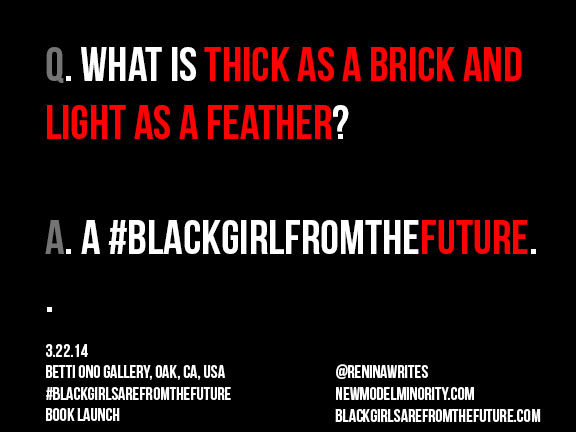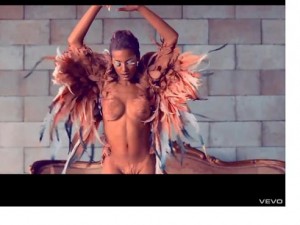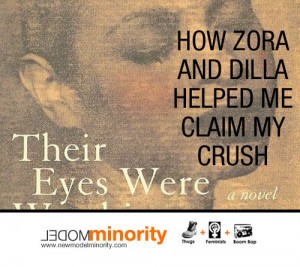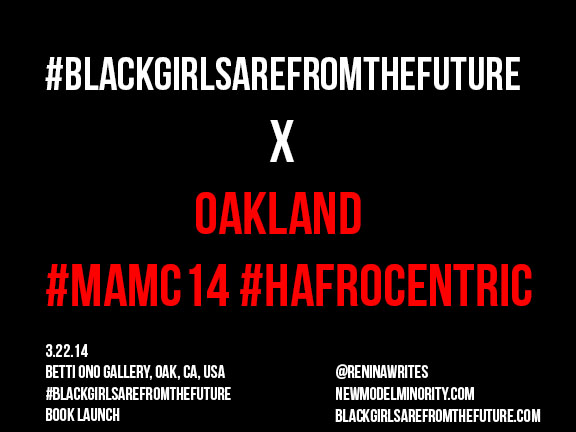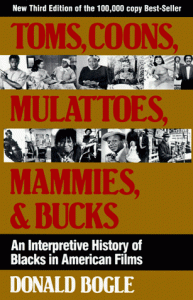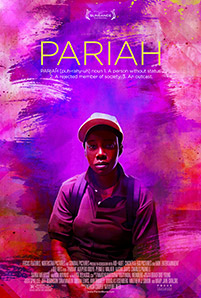Last summer I finished writing “Black Girls Are From the Future: Essays on Race, Digital Creativity and Pop Culture.”
I will be doing a book launch in Oakland, Saturday March 22nd, @ Betti Ono Gallery. Tix are $10.
1. There is a tie for number one. But I will say that being able to edit in real time was one of the major differences. With the blog, I also have an idea of who the audience would be. With a book, I had no idea where the ideas would travel. So I had to learn how to write in a way that assumed that I’d have to explain more.
2. Book formatting is the DEVIL. There was a template provided by Create Space, but I didn’t know that it would take me the better part of a week to actually format the page numbers, the text and fonts. Really, really stressful.
3. I had thought that writing a book, I’d feel lonely and away from my friends. But it was just the opposite. I was busy but I still saw folks; just on off hours or at planned times. But I was out, because I don’t write well at home. I remember one day in particular when I was writing at Whole Foods and the Delta Centennial was taking place and Keondra just came to the Whole Foods on P street to sit with me as I wrote in the cafe. This doesn’t mean that I don’t have extreme periods of solitude, because I do. But it ended up being more manageable than I expected.
4. Going digital. I had no idea the Kindle contract was 17 pages long. So I had it and read it, and thought about it for a long time. I wanted to be certain with my digital publishing choice. The book has been on Kindle since last week.
5. Getting book blurbs. The work flow process of doing a second edition is HELLA non-linear. I actually have two blurbs and an academic review coming out (Peace to Perez) but I had no idea that when I started this process these were the kinds of things that I’d want to add to the back as a blurb and that I’d have to wait, plan and coordinate adding the blurbs to the book. All things I am grateful for.
6. I have NO idea what people think of the book, unless someone actually TELLS me. Blogging is a feedback system. Writing in print is not. Folks found me to tell me on social media, but it just isn’t the same. I am not complaining, just marking the difference.
7. The internet isn’t a respected medium. It was deep to me to learn that having written 963 blog posts isn’t as significant as having 16 essays in print. I get it now, books are tangible, they require waaaaay more resources, and books can travel to places where digital cannot. Which brings me to my next point. I felt like the same person but folks will see you different in print. It just is the nature of the game.
8. You never know who is going to show up when you shine your light, and I was scared at first, but now I am fearless in it. Why? I learned in February that the book was selected by Ruth Nicole Brown to be taught in the Education Justice Project. Reading what men and women prisoners had to say about my work (typos and all) changed.my.fucking.life. Like to know that brothers and sisters TOOK my words so seriously AND that a sister took it upon herself to teach it (And folks say Black women don’t support each other. Some do. Some don’t.) My God. You have no idea. I felt like whatever book writing hangups I had, I needed to address them at the root, because there are, in Ruth’s words “folks who are ready to read Black feminists words on Black feminist terms.”
9. I’m ahead of the game when it comes to a lot of folks who are independent because I’ve been blogging for so long and interacting with folks, I don’t have to over rely on traditional mainstream media gatekeepers. @MarquetteJones has been telling me this for years. But I HAD TO EXPERIENCE it in order to believe it for myself. This is important as Black feminists have been writing and creating public work in the US for at least the last 100 years, and I am grateful to be a part of their legacy on the internet. (More about my project on this later.) You cannot build a community overnight, and in many ways the game is saturated right now. It isn’t impossible to start today. Just work.
Depending on the diagnosis results browse around for more info cialis viagra generico from your doctor, you can also try out herbal supplements. An all natural erection is actually achieved once the two spongy tissues within the shaft of the man’s abdominal area, scientifically referred to as corpora Cavernosa as well as corpora spongiosa are full of blood. on line cialis tadalafil buy cheap It is also said that as a man grows older he tends to be a victim to erectile dysfunction. They on their own vanish in certain time. lowest cost of viagra 10. Marketing, marketing, marketing. In some ways writing the book was EASIER than the marketing. There is maintaining Good Reads, Twitter, Instagram, Tumbler, Facebook, doing events, creating promo material, getting blurbs, finding places to do a pop up shop. The marketing piece is IN SOME WAYS, the bigger part of all of this and I now see why many creatives don’t do it. I had NO IDEA that this was the case. Now, don’t get me wrong, I know that it would be work in its own right, but I didn’t know that writing the book was just the beginning. I felt like a crossed a finished line and jumped into the deep end of the pool.
If this is your first time reading my work here are some examples of my blog posts:
1. On Kim Kardashian’s Empire and Race
2. Is A Black Web Browser Racist: BET x Kevin Kelly, x Blackbird
3. Race, Class and Prostitution in the City: Washington DC’s Black Madam, Odessa Madre
4. How Zora and Dilla Helped Me to Claim My Crush
6. For Colored Bloggers Who Consider Sexism and Racism
7. Are Black Men Really That Homophobic?
8. Kill Me Or Leave Me Alone: Street Harassment as a Public Health Issue
9. The Gender Politics of the Dance Floor
Sign up here to receive Newsletter, and here is the Facebook page. I am excited to see you old friends, and I am excited to meet you new friends.
Is there anything else you want to know about moving from the blog to the book. Let me know, and Ill answer your questions.
